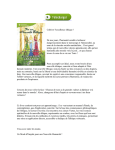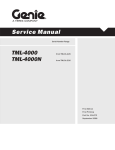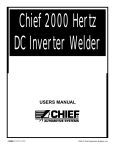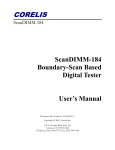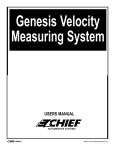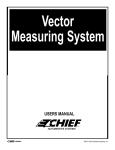Download Chief Manufacturing 638699 Automobile Accessories User Manual
Transcript
PIT BOSS Users Manual 2008 © Chief Automotive Technologies. PIT BOSS Users Manual CHIEF’S LIMITED ONE-YEAR WARRANTY & LIABILITY Chief Automotive Technologies warrants for one year from date of installation and/or purchase any components of its Pit Boss Lift system, which do not perform satisfactorily due to defect caused by faulty material or workmanship. Chief’s obligation under this warranty is limited to the repair or replacement of products which are defective and which have not been misused, carelessly handled, or defaced by repair or repairs made or attempted by others. CHIEF AUTOMOTIVE TECHNOLOGIES DOES NOT ASSUME RESPONSIBILITY FOR ANY DEATH, INJURY OR PROPERTY DAMAGE RESULTING FROM THE OPERATOR’S NEGLIGENCE OR MISUSE OF THIS PRODUCT OR ITS ATTACHMENTS. CHIEF MAKES NO WRITTEN, EXPRESS OR IMPLIED WARRANTY WHATSOEVER OF MERCHANTABILITY OR FITNESS FOR A PARTICULAR PURPOSE OR OTHERWISE REGARDING THE EQUIPMENT OR ANY PART OF THE PRODUCT OTHER THAN THE LIMITED ONE-YEAR WARRANTY STATED ABOVE. PIT BOSS Users Manual This owner’s manual is written to familiarize operators with the safe and efficient operation of the Chief PIT BOSS lift system. The PIT BOSS lift features Shop Hopper and vehicle lifting capabilities. IMPORTANT: 1. DO NOT attempt to operate the Chief PIT BOSS without first reading this entire manual. The lift is hydraulically positioned at various working heights suitable to the operator. 2. Complete safety information is highlighted throughout this manual and is identified by: NOTE: Illustrations shown in this manual may vary slightly from actual product This manual is not intended to replace Chief Automotive training. For information concerning training, contact Chief Automotive Technologies. 1 3. This safety alert symbol identifies safety information. Operator injury could result if these CAUTION notes are not followed. 4. Qualified service personnel must check operational capacity of the PIT BOSS lift system prior to its initial use and at intervals of no more than one year. Contact your authorized Chief Automotive Technologies representative for inspection. 5. Persons operating the PIT BOSS lift must be at least 18 years of age, must be trained in the operation of the PIT BOSS lift, and must have demonstrated their qualifications to the employer. They must also be specifically assigned to operate the PIT BOSS lift by the employer and this assignment must be in writing. PIT BOSS Users Manual IMPORTANT SAFETY INSTRUCTIONS When using your garage equipment, basic safety precautions should always be followed, including the following: 1. Read all instructions. 2. Care must be taken as burns can occur from touching hot parts. 3. Do not operate equipment with a damaged hose or if the equipment has been dropped or damaged – until it has been examined by a qualified service person. 4. Do not let a hose hang over the ledge of the table, bench, or counter or come in contact with hot manifolds or moving fan blades. 5. Care should be taken to arrange the hose so that it will not be tripped over or pulled. 6. Always unplug equipment from the air supply when not in use. 7. Loop hose loosely around pump stand when storing. 8. To reduce the risk of fire, do not operate equipment in the vicinity of open containers of flammable liquids (gasoline). 9. Keep hair, loose clothing, fingers and all parts of the body away from moving parts. 10. To reduce the risk of electric shock, do not use on wet surfaces or expose to rain. 11. Use only as described in this manual. Use only manufacturer’s recommended attachments. 12. ALWAYS WEAR SAFETY GLASSES. Everyday eyeglasses only have impact resistant lenses, they are not safety glasses. 2 PIT BOSS Users Manual General Safety Tips Tower Movement General DO NOT operate this machine unless: 1. You are authorized in writing by your employer. 2. All towers are properly secured to machine. 3. Vehicle’s wheels are blocked and parking brake is set. 4. Load is 8500 lbs or less. 5. Field of motion of load carrying device is free of persons and obstructions. WARNING! Fully engage tower leg into Shop-Hopper receptacle to prevent tower movement during the pull or during a raising or lowering procedure. When pushing tower, keep both hands on tower levers. Also, keep hands away from all pinch points. NOTE: The hose and pump will need to be stowed when moving towers around the shop. Persons operating the PIT BOSS lift must be at least 18 years of age, must be trained in the operation of the PIT BOSS lift, and must have demonstrated their qualifications to the employer. Pulling WARNING! To avoid severe personal injury to yourself and others: DO NOT position yourself close to, or inline with chains, clamps, or other accessories while pressure is applied to this system. DO NOT attempt to operate the PIT BOSS lift without first reading this entire manual. Always wear safety glasses when using the PIT BOSS lift or any of its accessories. To Prevent personal injury from flying objects: • Check all bolts, nuts, and clamps for deformation or elongation prior to each use. • Deformed or elongated materials must be replaced. • If materials look deformed, they are deformed. Replace them. Remove twist in chain before applying pressure to chain. Maintain a free space of 20 inches (50cm) minimum around all moving parts and pinch points on machine. Collar To avoid accidental dropping of tower collar, tighten collar locking knob and/or lower collar to bottom of tower. Raise / Lower Machine Collar locking knob must be tightened before removing tower chain from vehicle. When raising or lowering the PIT BOSS lift, be certain to secure the Shop-Hopper to the lift top. The clamps must firmly engage the tube holes. Lifting of persons is prohibited. Keep feet and objects clear of mainframe when lowering machine. 3 PIT BOSS Users Manual Raise / Lower Machine (continued) Chain To avoid personal injury or damage to equipment before operating the machine, make sure: Persons and objects are clear of machine. Hoses and other objects are free of the lift legs Oil spills must be cleaned up immediately to prevent slipping. Hoses on the floor can create a tripping hazard. The 3/8” tower chain is proof tested to 20,000 lbs. (90kN). To avoid personal injury or damage to property, DO NOT: • Heat chain or hook while repairing vehicle. 600 8F (316 8C) of heat on chain will weaken it. • Tip load chain hook • Pull with twisted chain links Loading / Unloading Machine DO NOT run over air hoses or hydraulic lines when loading or unloading vehicles. Hydraulics DO NOT exceed the machine’s 8500 lbs. (3850 kg) lifting capacity. Keep pump away from excessive heat or flames. The surrounding temperature should not exceed 122° F (508 C). Shop Hopper Always release hydraulic disconnecting hydraulic hoses. To avoid injury, always use an assistant when lifting and positioning anchoring crossbars. before If pump fails to shut off, disconnect air supply and contact an authorized Chief Automotive Technologies service representative. When making heavy pulls, tie the anchoring bases back to the deck using a chain and turnbuckle assist. All components must be replaced with Chief Automotive Technologies authorized replacement parts. Keep loads centered. Always have assistance hopper. pressure when moving shop Improper handling and/or modification of parts is forbidden and may cause a hazardous situation for the user. Such action immediately voids the warranty and releases the manufacturer from all liability. Avoid sloped surfaces whenever possible. If a sloped surface must be crossed, use extreme caution and always roll straight up and down the slope, NEVER sideways to it. Keep pump in upright position. DO NOT lay pump on its side. Always apply wheel brakes when parked. Fill pump reservoir with all cylinders. maintenance section). During docking, entire perimeter of Shop-Hopper is a potential pinch point. Take care when raising and lowering the deck to load and unload the Shop Hopper. (see DO NOT overfill pump reservoir. Operational Capacity Qualified service personnel must check operational capacity of the PIT BOSS lift prior to its initial use and at intervals of no more than one year. Contact your authorized Chief Automotive Technologies representative for inspection. Optional Steps / Ladders Use only approved steps and ladders when working on or around this equipment. 4 PIT BOSS Users Manual Hydraulic System Components General The Chief PIT BOSS is powered by a pneumatically operated hydraulic pump, which is operated by a foot pedal(see Figure 1) NOTE: WARNING: The PIT BOSS lift has a high pressure hydraulic system, it builds hydraulic pressure quickly. Be aware of this quick reaction when making pulls or lifting vehicles. Figure 1 To avoid personal injury or damage to property: When disconnecting hydraulic quick couplers, some fluid spillage may occur. Always clean up any hydraulic fluid spillage from floor or work area. Initial Setup The PIT BOSS lift requires a compressed air supply to activate the safety lock releases. Before using the PIT BOSS, it is necessary to install a customer supplied air coupler. The PIT BOSS lift pump is equipped with a ¼” Female NPT port on the back. (See figure 1) Figure 2 The PIT BOSS lift pump must be connected to the hydraulic hose at the end of the lift. First connect hydraulic quick coupler (see Figure 2). Be certain the locking ring is completely tightened. Read the next section on pump usage then lift the PIT BOSS lift to its highest position. Press the down lever on the pump until the PIT BOSS lift completely settles into the top locking height. Connect the pneumatic line from the pump to the coupler on the PIT BOSS. (To connect a pneumatic line, firmly push the hose into the fitting until it is fully seated.) IMPORTANT: When connecting hoses, check for any interference of lines with moving parts. 5 PIT BOSS Users Manual Pump Usage To activate hydraulic pump and apply pressure to system to raise machine, depress the up pedal on the foot pump (See figure 3). The pump will build hydraulic pressure in the system to activate lift cylinders. To disengage the hydraulic pump, release the foot pedal on the pump. This action stops the flow of hydraulic oil to the system being operated: however, the system holds existing hydraulic pressure. Figure 3 To release hydraulic pressure, depress the down pedal of the foot pump. (See figure 4). This will release the hydraulic pressure in the system and return hydraulic oil to the pump reservoir. CAUTION: To prevent damage to the pump and hydraulic cylinders, DO NOT operate pump when cylinders are fully extended. (If possible, stop supplying pressure before cylinders reach full extension) Figure 4 Lock Release The lock release is a pneumatic valve that must be pressed to deactivate the lock arm and lower the Pit Boss (see Figure 5). To Lower Machine 1. Activate lock arm release by depressing and holding the brass button on the pump stand. (See figure 5) 2. Depress and hold the “UP” pedal on the foot pump to raise the machine until the safety lock arm audibly releases from its lock position. (See figure 3) 3. Figure 5 To Raise Machine While continuing to hold down the “UNLOCK” button, depress and hold the “DOWN” pedal on the foot pump. • CAUTION: • Before lowering machine, clear all obstacles from under and around machine. DO NOT allow anyone or anything to ride on machine or be under machine during lowering procedures. Adjust Working Height The PIT BOSS lift has six (6) working heights from 9 inches (480 mm) to 45 inches (1220 mm). 6 1. Activate pump by depressing and holding “UP” pedal on pump. 2. After machine is slightly above desired working height, as indicated by the audible drop of the lock arm into its locking position, release “UP” pedal on the pump. 3. Depress and hold “DOWN” pedal on the pump to lower machine into mechanical stops. PIT BOSS Users Manual Docking the Shop-Hopper with the PIT BOSS 1. Retract the mounting clamps on the PIT BOSS and remove any frame adapters from the lift arms (see Figure 6). 2. Position the Shop-Hopper over the PIT BOSS and align the square holes of the center tubes with the mounting clamps (see Figure 7). NOTE: Figure 6 If the PIT BOSS is not mounted with the table top flush with the floor the Shop-Hopper must dock on the lift from the side. 3. Raise the PIT BOSS until the Shop-Hopper fully sits on the flat of the lift. 4. Slide the mounting clamps fully into the square tubes of the Shop-Hopper and tighten with a 30mm wrench (see Figure 8) Loading a vehicle Figure 7 When loading a vehicle on to the PIT BOSS lift observe the following precautions. • CAUTION: • • • • CAUTION: • • When driving or winching vehicle on or off machine, use a helper to guide. When positioning a vehicle over the lift the vehicle should be centered over the lift from side to side as closely as possible. The center of gravity of the vehicle should be as close to the center of the lift as possible. DO NOT exceed 8500 lbs. Lifting capacity of PIT BOSS lift. Figure 8 Before raising lift, verify that all lift pads securely mate to a suitable lifting point on the vehicle. If the frame of the vehicle is too narrow for the lift arms use the offset arm mounts. ONLY USE THE OFFSET ARM MOUNTS WITH THE ARMS FULLY RETRACTED SEE FIGURE 9 Figure 9 7 PIT BOSS Users Manual Shop-Hopper Removable Casters The removable casters of the Shop-Hopper give three primary benefits. First, they allow the Shop-Hopper to be docked with the Fuzion at both ends. Second, they allow the Fuzion to be lowered into the lowest position with the Shop-Hopper docked. Third, they allow the Shop-Hopper to sit on the floor when removed. Removable Caster Mounting The removable casters can be mounted from the ends and from the sides at both ends of the Shop-Hopper. For normal use all casters should always be mounted from the sides for maximum stability. Mounting one pair from the end and the other pair from the side allows the Shop-Hopper to be docked with the Fuzion. To prevent personal injury or WARNING: property damage never mount both pairs of casters from the ends of the Shop-Hopper. (See figure 13) Figure 10 To remove the casters the Shop-Hopper must first be raised at least 4 inches. Next, lock the swivel lock mechanism on the caster to be removed. Third, remove the hair pin clip from the retaining pin. (See figure 10) Then slightly lift the caster end of the mount and remove the pin at the same time. With the pin removed the mount will pivot down. (See figure 11) Continue to pivot the mount down and unhook the mount from the lock. The mount will then slide freely from the Shop-Hopper. (See figure 12) Figure 11 To install the casters, the Shop-Hopper must be lifted at least 16” off the floor. Installation is similar to removal with some additional steps. First, determine the most likely use of the Shop-Hopper. If it is to be docked with the Fuzion, pick which end will be to the front of the Fuzion. That end will have to have the casters mounted from the end. If the Shop-Hopper is not likely to be docked, all casters should be mounted from the side for maximum stability. (See figure 13) After this has been done, the casters can be installed at the appropriate locations. Figure 12 WARNING To prevent personal injury and property damage. Always fully engage the pin and hair pin clip when installing the casters. Figure 13 8 PIT BOSS Users Manual Shop-Hopper Tower The Shop-Hopper tower is an optional accessory that allows light pulls to be done with the Shop-Hopper. (See figure 14) This tower mates to any of the 12 square holes around the bottom of the Shop-Hopper. In order to properly use the Shop-Hopper tower, the tower must be fully inserted into one of the square holes. (See figure 15) WARNING To prevent personal injury and property damage. Always fully engage the Shop-Hopper tower mount into the Shop-Hopper before making any pulls. Figure 14 While the Shop-Hopper is on the PIT BOSS it is permissible to use one of the center square holes as a tower location. Remove only one hold down clamp and insert the tower into that location if needed. WARNING To prevent personal injury and property damage. Always replace the hold down clamp removed when finished with the pull. Once engaged into the Shop-Hopper, the tower may be pivoted in the mount to achieve the desired pulling angle. To do this, lift the spring loaded pull pin on the tower arm. (See figure 16) Next, rotate the tower and fully engage the pull pin into the desired location. Figure 15 The Shop-Hopper tower is hydraulically powered by an air over hydraulic pump similar to the PIT BOSS. The pump must be connected to an air supply to function. The vertical angle of the pull is controlled by adjusting the up and down position of the tower collar on the tower pipe. The horizontal angle of the pull is adjusted by tower placement and the rotation of the tower collar on the tower pipe. WARNING To prevent personal injury and property damage. Never lower the PIT BOSS below the normal ride height of the Shop-Hopper Tower with the tower engaged into the Shop-Hopper. 1. To adjust slack tower chain, grip chain on each side of tower. Lift out on tail of chain until it is approximately 45 degrees from tower. Then disengage chain from tower head and pull chain to either increase or decrease amount of slack. (see figure 17) 2. Support collar with one hand while loosening collar locking knob with opposite hand. Then position collar approximately three inches (75 mm) above desired pulling height and retighten collar locking knob. (see figure 18) Figure 16 Figure 17 9 PIT BOSS Users Manual To Operate Towers (continued) 3. Let tower chain hang free momentarily to remove twist. Then without twisting chain, attach hook to vehicle. Pull on tail end of chain to remove slack (see figure 19). Loosen collar locking knob and lower collar. IMPORTANT: Remove twist from chain before lowering collar. Make sure that chain links between collar roller and hook align. 4. Attach pump’s hydraulic hose to tower quick coupler at the base of the tower pipe. 5. To operate pump, follow usage procedures on page 8. CAUTION: CAUTION: Figure 18 To prevent damage to tower assembly, pulls must not exceed a 45 degree angle from tower base. (see figure 20) Figure 19 To avoid personal injury or damage to equipment, DO NOT: • Heat chain hook while repairing vehicle. 600 8F (316 8C) of heat on chain will weaken it. • Tip load chain hook. • Pull with twisted chain links. WARNING To avoid severe personal injury to yourself and others: DO NOT position yourself close to or in-line with the chains, clamps, or other accessories while pressure is applied to this system. IMPORTANT: • Figure 20 DO NOT tighten collar locking knob while pressure is applied to the system because it will be impossible to loosen the knob without pressure on the system. When tower is no longer needed, remove tower chain and hook from vehicle, and store collar using one of the two methods shown in figures 21 & 22. • CAUTION: • • Collar locking knob must be tightened before removing tower chain and hook from vehicle. Collar locking knob must be tight when collar is not in use. Store collar at bottom of tower pipe or support collar with tower chain. Figures 21 & 22 10 PIT BOSS Users Manual Shop-Hopper Vehicle Anchoring The Shop-Hopper vehicle anchoring system consists of four anchoring stands with clamp bars and two cross bars. Together with the cross bars, the anchoring stands and clamp bars provide a positive means of securing a vehicle to the Shop-Hopper. Crossbar Mounting The crossbars can be mounted anywhere along the Shop-Hopper as needed for the vehicle mounting locations. Each crossbar has four bolt locations that must be used to securely mount to the Shop-Hopper. (See figure 23) For easier alignment of the crossbars with the desired holes, use one of the pins from the anchoring stands as an alignment tool. Once the crossbars have been placed, firmly tighten the bolts with a 30mm wrench. Figure 23 Anchoring Base Mounting The anchoring stands are mounted to the crossbars. They can be mounted anywhere along the track that the bar will slide. (See figure 24) Once the anchoring stands have been placed, they also must be securely mounted by tightening the bolts with a 30mm wrench. Two Piece Anchoring Figure 24 The clamp bars mount to the adjustable height tube of the anchoring stand. This assembly is called Two Piece Anchoring. Each bar fits between the ears on top of the tube. The bars are secured with the bolt and nut at the center of the clamp and tightened with a 30mm wrench. (See figure 25) The advantage of the Two Piece Anchoring is that the clamp bars can be attached to the pinch welds of the vehicle first. Then the anchoring bases and crossbars can be positioned to mount to the clamps. This arrangement will make it easier to load a vehicle on the Shop-Hopper using a 2-post lift. Figure 25 WARNING To prevent personal injury and property damage. Always fully tighten all nuts and bolts when anchoring a vehicle before making any pulls. 11 PIT BOSS Users Manual Machine Maintenance Cleaning and Lubricating Check and Inspect These components should be checked monthly and anytime a problem is suspected. CAUTION: To avoid personal injury when performing any maintenance function, always wear safety glasses and safety shoes. These components should be cleaned and lubricated as specified for trouble free operation and extended service. When lubricating use the following: Oil – Use 30 weight motor oil for all components requiring lubricating oil. Grease – Use a SUS750 lithium type grease such as lubricate #630-2 for all components requiring grease Tower Heads Tower Chains The tower chains with the Chief Shop-Hopper Towers are high quality, high strength chains/hooks. If replacement is required, purchase only the original Chief product from an authorized Chief Automotive representative. • CAUTION: • • DO NOT heat chain or hook while repairing vehicle – 600F (316C) of heat on chain will weaken it. DO NOT tip load chain hook. Tip loading chain hook will stress hook beyond its designed capability and could cause hook to fail. DO NOT pull with twisted chain links. Pulling with twisted chain links will stress chain links beyond their designed capability and could cause chain to fail. Grease tower heads annually 1. Remove tower chain from tower head 2. Remove tower head from tower pipe 3. Clean dirt from tower head pipe and where tower head pipe rubs on inside of tower pipe. 4. Apply grease to tower head pipe 5. Reinstall tower head and tower chain Collars Clean and lubricate collars monthly. 1. Use compressed air to blow out dirt or dust that collects between collar ears and rollers. CAUTION: Tower chains must be inspected for wear, nicks, gouges, stretched and bent links. If found, replace chain. 2. Tower chain hooks must be inspected for twist and stretched openings. If found, replace chain. Wear safety glasses while using compressed air to blow out dirt and dust. Place a few drops of oil on the roller pin between roller and collar ears (each side). Then turn roller a few times. Roller must turn freely Loading Ramps Eliminating Air in Hydraulic System Inspect loading ramps making sure loading ramp slots fully engage the pinning lugs at rear of machine each time mainframe is raised or lowered. If hydraulic system is opened to replace a system component, it is necessary to bleed air from system prior to using it. Power and Control Hoses Bleeding Air in System at Tower Cylinder Inspect power and control cords for worn hoses or other damage. If found, replace hose(s). 1. Connect the hydraulic line to the tower cylinder. 2. Remove the tower head and chain 3. Fully extend tower cylinder by depressing and holding “UP” pedal on the foot pump until tower gauge shows 2000 psi of pressure on system. 12 PIT BOSS Users Manual Bleeding Air in System at Tower Cylinder (Continued) Refill Hydraulic Fluid Reservoir 4. While holding rag over the top of the cylinder to prevent oil spray, use a 3/16” T-handle allen wrench, loosen cylinder top bolt ½ turn. The hydraulic pump contains 1.75 quarts (1.7 liters) of hydraulic oil. When refilling or adding oil, fill to within 1” (25 mm) of fill port using SUS 215 viscosity @1008F (388C) 10W hydraulic oil. 5. Rapid, side-to-side motion of the T-handle may be necessary to unseat the seal washer at the top of the cylinder. CAUTION: 6. 7. Trapped air or trapped air/oil mixture (indicated by foam in the oil) should escape from top of cylinder. Wipe up escaping oil with rag. When cylinder is completely bled, only clean oil should escape from top of cylinder. NOTE: 8. Wear safety glasses to protect eyes from hydraulic oil in the event it squirts past rag. Fill pump reservoir with all cylinders retracted and lift in lowest position. DO NOT overfill pump reservoir. CAUTION: Scissor Lift Assembly All scissor lift pivot points are permanently lubricated and do not require maintenance except for occasional cleaning. Scissor Lift Base Using compressed air, blow dirt and debris from the base. If necessary, use stiff brush to remove build up of dust and paint on the surface. It may be necessary to tighten top cylinder bolt and repressurize system to 2000 psi and repeat procedure Replace tower head and chain. Lower tower cylinder and refill reservoir to within 1” of fill port with all cylinders in retracted position. CAUTION: Wear safety glasses while using compressed air to blow out dirt and dust. NOTE: Refer to Parts Manual for detailed exploded views of referenced parts. Contact Chief Automotive with any questions regarding the usage or maintenance of the PIT BOSS system. Machine Placement The PIT BOSS System has many accessories that add to the overall footprint of the lift. Use Figure 26 as a guide to plan for the working space needed when installing the PIT BOSS. Figure 26 13 PIT BOSS Users Manual Machine Leveling 1. Position the PIT BOSS lift in the highest working position. 2. Use the scissor base as a template and a drill guide to install four (4) concrete anchors (see Figure 27 & 28). See Anchoring section for more information 3. Move around the machine placing a level across the front, rear, and down both sides of the top. The machine should be level in all working heights. 4. Adjust level by adding the shims (see Figure 29). Repeat this process until the machine is level on all corners. 5. Once the machine is level tighten the nuts on the concrete anchors. NOT use an impact wrench for tightening 6. Depending on how many shims where placed under the PIT BOSS, shims may need to be added to the Shop-Hopper. Shims for the Shop-Hopper are placed between the caster and the frame. Figure 27 DO Figure 28 Figure 29 14 PIT BOSS Users Manual Machine Anchoring 1. Anchors must be installed at least 5-11/16” from any edge or seam in concrete. 2. The concrete must be at least 4-1/4” thick with a compressive strength of 3000psi. 3. Use a hammer drill with a carbide tip, ¾” diameter solid drill bit. The bit tip diameter should be to ANSI Standard B95.12-1977 (.775” to .787”). 4. Keep drill perpendicular to the floor while drilling. Let drill do the work. Drill the hole completely through the slab. Clean dust from hole using a vacuum. (See Figure 30) 5. Assemble the washers and nuts onto the anchor bolts. Thread the nuts onto the anchor bolts where the top of the nuts are just above the top of the bolts, as shown. 6. Using a hammer, carefully tap the anchor bolts into the concrete until the washer rests against the base plate.(See Figure 31) 7. If more than 2” of shimming is required, do not use the anchors and shims provided with the lift. Use longer anchors and fabricate larger shims from steel flat. 8. Once the machine is level, tighten the anchor bolts to 150 ft-lbs. Do not use an impact wrench on anchor bolts. (See Figure 32) Figure 30 Figure 31 Figure 32 15 PIT BOSS Users Manual Machine Ramps and Tread ways The ramps and tread ways are used when the PIT BOSS has not been placed within a pit. The tread ways give 6 inches of elevation enabling the vehicle to be driven over the PIT BOSS. 1. Install the tread way locating brackets. The brackets bolt on the ends of the lift base and are each secured with two 3/8 bolts (see Figure 33). 2. Each tread way has a piece of channel iron on the bottom. Select four tread ways without wheel stops and insert the channel iron of the tread ways completely into the locating brackets (see Figure 34 and Figure 35). Be certain the ends of the tread ways with out bolts are away from each other (see Figure 36). Figure 33 Figure 34 Figure 36 3. Now repeat step 2 for the other side of the PIT BOSS. Next locate the two tread ways with wheel stops and place them at the lift cylinder end. Opposite the wheel stops are keyholes in the tread ways. Line the keyholes up with the exposed bolts on the mating tread way and insert them (see Figure 37). 4. Lock the remaining two tread ways on the opposite end as the wheel stops. Place the ramps with the slots over the bolts (see Figure 38). Figure 35 Figure 37 Figure 38 16 PIT BOSS Users Manual Machine Pit Layout The PIT BOSS is designed specifically for use in a flush mount pit. Figure 39 shows the pit dimensions. For maximum effectiveness it is essential that the hydraulic and air lines be run in conduit under the surface of the floor. The conduit should be 2” inside diameter and must be acceptable for the use with concrete. Where ever the conduit emerges will mark the location of the pump and stand. Be certain this is an acceptable area clear of traffic. The profile of the PIT BOSS and accessories is shown in Figure 26. Placement of the pit should take into account these accessories plus additional space needed for a comfortable work area. Figure 39 Troubleshooting PROBLEM Pump will not Run CAUSE Air supply disconnected Air supply not energized Bad pump Pump will not build pressure or builds pressure slowly Hydraulic fluid low Contamination in fluid Contamination in cylinders Pump will not hold pressure Pump stalls or will not start under pressure Hydraulic oil leak Contamination in fluid Too much weight Tower cylinder jumps Tower cylinder will not extend Collars jump under load Insufficient air supply Air in hydraulic system Auxiliary line valve closed Auxiliary line not connected to tower Lift switch turned on Pump will not build pressure Improper fit between collar and tower pipe POSSIBLE SOLUTION Plug in air supply Turn on air supply Replace pump. Contact Chief Automotive Service Representative for replacement. Fill fluid reservoir to within 1” (25 mm) of top with SUS215 viscosity @ 100°F (38C) 10W hydraulic oil with all cylinders down and machine in loading position. Remove and clean fluid. Contact Chief Automotive Service Representative. Remove and inspect cylinders. (Refer to parts manual). Contact Chief Automotive service representative. Check hoses, fittings, cylinders, and quick couplers for leaks. Tighten or replace if necessary Remove and clean elbow fittings at cylinders. Contact Chief Automotive Technologies Service Representative. Maximum total lift capacity (including 2000 lb Shop Hopper) is 8500 lbs. Use different air supply. Bleed hydraulic system Open auxiliary line valve one turn Connect auxiliary line to tower Turn off lift switch See pump problems above Refit collar – Contact Chief Automotive service representative. 17 P.O. Box 1368 Grand Island, Nebraska 68802-1368 Phone: 308/384-9747 Fax: 308/384-8966 www.chiefautomotive.com Chief reserves the right to alter product specifications and/or packaging components without notice Form 1-PIT BOSSUM (rev 01/08) Part No. 638699




















